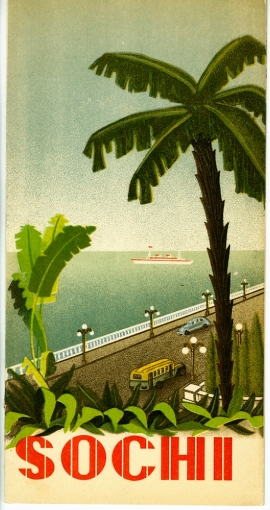MCNY Blog: New York Stories
Iconic photos of a changing city, and commentary on our Collections & Exhibitions from the crew at MCNY.org
A visit to Sochi, 1939.

Postcard issued by Grinnell Lithographic Company. Union of Soviet Socialist Republics. New York World’s Fair, Exposition Souvenir Corporation, ca. 1939. Museum of the City of New York. 88.63.17
What do the 2014 Winter Olympics and the 1939 New York World’s Fair have in common? The promotion of Sochi, Russia as a tourist destination.
As mentioned in a earlier post, the 1939 New York World’s Fair featured state and international pavilions. These spaces served to educate visitors to the Fair about the history, politics, arts, culture, economy, and industry of a particular location; and also served as tourism bureaus. The Pavilion for the Union of Soviet Socialist Republics, or Soviet Union, as Russia was known in 1939, was an example of increased cooperation with the West evident in the 1930’s.
Materials such the “Intertourist Map of the Soviet Union” (shown below) featured example travel itineraries through the U.S.S.R. One such “tour” spent four days in Sochi, located on the northeast coast of the Black Sea. Note the total cost for a third class travel package – $110.00.

Sochi travel brochure. Intourist, ca. 1939, in the 1939-1940 New York World’s Fair Collection. Museum of the City of New York. 95.156.61.
The Soviet Pavilion also distributed informational brochures on specific destinations. The brochure for Sochi is to the right. While one would expect some obvious changes in the 75 years in between the 1939 New York World’s Fair and the 2014 Winter Olympics, one difference in the way the city is marketed for the two events jumps out at me right away – the climate. The brochure to the right depicts a downright tropical scene. According to the text inside the brochure “The Caucasian shores of the Black Sea, that blissful, sunny corner of the globe, has [sic] always enticed the traveler with the incomparable beauty of its scenery and the wonderful healing power of its climate.” Yet the Sochi of the Winter Games is just that – wintry.
Before I opened the Sochi travel brochure, I assumed it must look the way I would image most of Russia, and any city hosting the Winter Olympics to look: cold and snowy. This photograph to the left, of the Soviet Pavilion covered in snow during its dismantling in Flushing Meadows Park following the conclusion of the 1939-1940 New York World’s Fair much better fits the image I had in mind. However, the fact is, the climate hasn’t changed; Sochi is simply a city that has seasons. According to the Washington Post, Sochi is the warmest city to ever host the Winter Olympics, and some initial concerns for this year’s games included avalanche risk and snow drought.
The mysteries of Sochi don’t end with the climate, however. The 1939 travel brochure boasts, “[T]his lovely resort stretches for 25 kilometers along the sea coast. Magnificent sanatoria, rest-homes, clinics, and hotels nestle amid…fine bathing places and aquatic sport stations.” Once again, I’m surprised. The word “resort” evokes images such as this one:

Excerpt from Sochi travel brochure, 1939, in the 1939-1940 New York World’s Fair Collection. Museum of the City of New York. 95.156.61.
But “sanatoria, rest-homes, and clinics,” brings to mind something like this:

Excerpt from Sochi brochure, 1939, in the 1939-1940 New York World’s Fair Collection. Museum of the City of New York. 95.156.61.

Nalchick travel brochure. Intourist, ca. 1939, in the 1939-1940 New York World’s Fair Collection. Museum of the City of New York. 95.156.58.
Sarah Kanowski of the Australian Broadcasting Corporation reports that these sanatoria were the destinations of many Soviet workers who spent up to six weeks “cleari[ing] the coal dust from their lungs.” While these days, the “resort” aspects of the city seem to outweigh the “clinical” attractions, Sochi still offers curative relaxation, as shown in this photo essay by Simon Schuster from Time.
One still wonders, however, in a country so known for its cold temperatures that the 1939 World’s Fair featured a “Pavilion of the Arctic” as part of the greater Soviet Pavilion, why one of the warmest cities in Russia was chosen for the Winter Olympics. Why not somewhere like Nalchik, which the brochure to the right describes as featuring a “mantle of snow and snow-clad ridges?” Perhaps even more remarkable is the glimpse we have at pre-Cold War Russia through the lens of the country’s own tourism marketing materials, and the ability to look at the city now, as it hosts one of the premier sporting events in the world.
The Museum is grateful to the Council on Library and Information Resources , whose support made it possible to share these finds from the 1939 -1940 New York World’s Fair Collection as a result of a generous Cataloging Hidden Special Collections and Archives grant from the Council on Library and Information Resources (CLIR).




Thanks for an enlightening article!
Pingback: Celestial Sphere, Color Movies, Gardens on Parade! | MCNY Blog: New York Stories